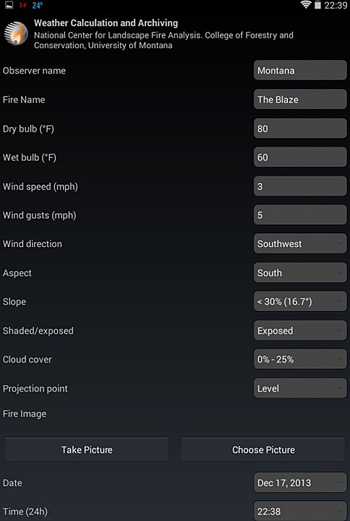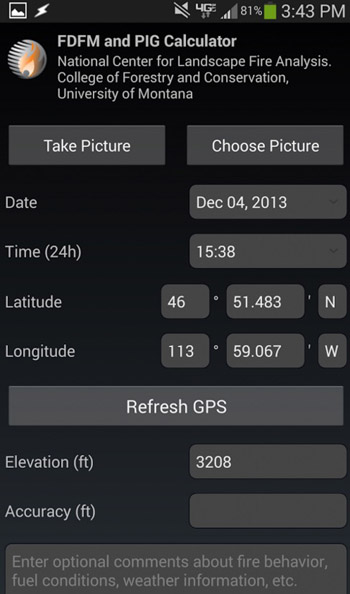A modern smartphone has many times the processing power of the computers on the Apollo spacecraft that took astronauts to the moon. Increasingly, wildland firefighters in the field are taking advantage of the smart brilliant devices in their pockets.
An article published in Fire Management Today (in the third quarter of 2015) covers two smart phone applications, or apps. After the user inputs the current weather and environmental conditions they can calculate various parameters and share them via mail or use various archiving options. One of the apps even uploads data to a remote computer server where advanced simulations can be performed which then return forecasts for the next 3 to 12 hours.
Fire Weather Calculator
(These images are screen shots from the app.)
Below, FDFM and PIG, are Fine Dead Fuel Moisture and Probability of Ignition. The app can harvest information from the smart phone and insert it into the fields, including time, date, latitude, longitude, and elevation.
From Fire Management Today:
This application allows the user to input traditional observations (e.g., dry bulb, wet bulb, etc.) and have the application calculate critical information, such as relative humidity and probability of ignition, which both saves time and ensures consistency between weather observers. More importantly, however, is the ability to archive and share these digital observations with other users and managers in real time. This application allows for more streamlined management of weather information, a critical aspect of any fire event. The ability to share observations, particularly if many users are archiving their observations, will lead to a very useful archive of crowd-sourced data that will be used to create value-added products, such as the calculations of 3-dimensional weather fields that could be shared with personnel to increase their situational awareness.
Fire Weather Calculator is for Android devices and iPhones.
Topofire Weather app
The Topofire Weather app takes the weather calculations to the next level, however it is no longer available. In searching for it we contacted one of the authors of the article, Matt Jolly, a research ecologist at the Missoula Fire Sciences Laboratory, who told us that it has been removed because they “are working on better options for displaying geographic information across all devices, rather than just a few platforms. We are almost ready to release it but development is going slowly right now.”
Topofire Weather looks like it was rather intriguing, as you can see from the description in Fire Management Today:
Similar to the Fire Weather Calculator app described above, this application allows users to enter a suite of fire weather observations that are normally collected on incidents. These observations, as well as the time and location, are sent directly to the TOPOFIRE server, where they are permanently archived and can be made available to users and fire weather forecasters. Weather information entered into the phone can then be used to parameterize the WindNinja simulation model, using either current observations or gridded data from the Real-Time Mesocale Analysis dataset (RTMA).
Users can also request forecasts for the next 3 to 12 hours, using data from the National Digital Forecast Database. Model simulations are then run on the TOPOFIRE server, and outputs are returned to the user’s phone in the form of a keyhole markup language (.KML) file that can be opened on the phone on GoogleEarth.
(The image above is from the article in Fire Management Today. Click on it to see a larger version.)
The Topofire Weather app apparently required access to government computer servers, which may prevent the ordinary user from being able to take advantage of its entire functionality.
We will look forward to the next generation of the app.



